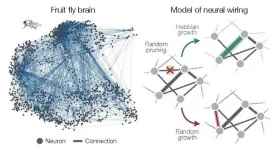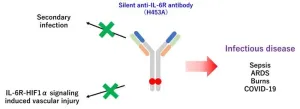(Press-News.org) Over the last decades, air pollution emissions have decreased substantially; however, the magnitude of the change varies by demographics, according to a new study by Columbia University Mailman School of Public Health. The results indicate there are racial/ethnic and socioeconomic disparities in air pollution emissions reductions, particularly in the industry and energy generation sectors. The findings are published in the journal Nature Communications.
The research provides a national investigation of air pollution emission changes in the 40 years following the enactment of the Clean Air Act (CAA). Until now, studies have primarily focused on evaluating air pollution disparities at a single time point, focusing on pollutant concentrations instead of emissions. A focus on emissions, however, has more direct implications for regulations and policies. In this study, the researchers used county-level data to evaluate racial/ethnic and socioeconomic disparities in air pollution emissions changes in the contiguous U.S. from 1970 to 2010.
“The analyses provide insight on the socio-demographic characteristics of counties that have experienced disproportionate decreases in air pollution emissions over the last forty years,” said Yanelli Nunez, PhD, the study’s first author, who is a scientist in the Department of Environmental Health Sciences at Columbia Mailman School of Public Health and affiliated with PSE Healthy Energy. Additionally, by analyzing air pollution emissions, the researchers identified specific pollution source sectors that are potentially important contributors to air pollution exposure disparities.
Nunez and colleagues leveraged air pollution emissions data from the Global Burden of Disease Major Air Pollution Sources inventory to analyze air pollutant emissions from six pollution source sectors: industry (sulfur dioxide), energy (sulfur dioxide and nitrogen oxides), agriculture (ammonia), on-road transportation (nitrogen oxides), commercial (nitrogen oxides), and residential (particles of organic carbon).
On average, national U.S. air pollution emissions declined substantially from 1970 to 2010 from all source sectors the researchers considered except for ammonia emissions from agriculture and organic carbon particle emissions from the residential sector, which the researchers indicate is primarily from using solid biofuels for indoor heating. The most pronounced emission decreases were observed for sulfur dioxide from industrial and energy generation activities. Nitrogen oxide emissions from transportation, commercial activities, and energy generation decreased moderately.
Despite the overall downward trends for most pollutants, the researchers found that certain populations experienced relatively smaller reductions or even increases in air pollution emissions. For instance, an increase in a county's average Hispanic or Indian American population percentage resulted in a relative increase in sulfur dioxide, nitrogen oxides, and ammonia emissions from the industry, energy generation, and agriculture sectors, respectively. Additionally, an increase in the county median family income was linked with an increase in the magnitude of emissions reductions in every pollution source sector the researchers analyzed, except agriculture.
“Air pollution emissions do not perfectly capture population air pollution exposure, and we also know that neighborhood-level air pollution inequities are common, which we were not able to analyze in this study given the data at hand,” noted Marianthi-Anna Kioumourtzoglou, ScD, associate professor of environmental health sciences at Columbia Mailman School, and senior author. “In this study, we provide information about potential racial/ethnic and socioeconomic inequalities in air pollution reductions nationwide from major air pollution sources, which can inform regulators and complement local-level analysis.”
“Policies specifically targeting reductions in overburdened populations could support more just reductions in air pollution and reduce disparities in air pollution exposure,” observed Dr. Nunez. “This is an important lesson gained from 53 years of Clean Air Act implementation, which is particularly relevant as we develop policies to transition to renewable energy sources, which will have a collateral impact on air quality and, as a result, on public health.”
Co-authors are Jaime Benavides, Jenni A. Shearston, Misbath Daouda, and Jeff Goldsmith, Columbia University Mailman School of Public Health; Joan Casey, Columbia Mailman School and the University of Washington; Elena Krieger, PSE Healthy Energy; Lucas R.F. Henneman, George Mason University; and Erin McDuffie, University of Washington.
The study was supported by National Institute of Environmental Health Sciences, (P30 ES009089, R01 ES030616, R01 ES028805 and T32 ES007322), The Thomas F. and Kate Miller Jeffress Memorial Trust, Bank of America; and Health Effects Institute (HEI, R-82811201).
Columbia University Mailman School of Public Health
Founded in 1922, the Columbia University Mailman School of Public Health pursues an agenda of research, education, and service to address the critical and complex public health issues affecting New Yorkers, the nation and the world. The Columbia Mailman School is the fourth largest recipient of NIH grants among schools of public health. Its nearly 300 multi-disciplinary faculty members work in more than 100 countries around the world, addressing such issues as preventing infectious and chronic diseases, environmental health, maternal and child health, health policy, climate change and health, and public health preparedness. It is a leader in public health education with more than 1,300 graduate students from 55 nations pursuing a variety of master’s and doctoral degree programs. The Columbia Mailman School is also home to numerous world-renowned research centers, including ICAP and the Center for Infection and Immunity. For more information, please visit www.mailman.columbia.edu.
END
US air pollution rates on the decline but pockets of inequities remain
Decreases more substantial in high-income neighborhoods
2024-01-17
ELSE PRESS RELEASES FROM THIS DATE:
Fly brain, mouse brain, worm brain: They all network the same
2024-01-17
New York, January 17, 2024 — In all species, brain function relies on an intricate network of connections that allows neurons to send information back and forth between one another, commanding thought and physical activity. But within those networks a small number of neurons share much stronger connections to one another than all the others. These abnormally strong connections—known as “heavy tailed” based on the shape of their distribution—are thought to play an outsized role in brain function.
Researchers ...
Surprisingly simple model explains how brain cells organize and connect
2024-01-17
A new study by physicists and neuroscientists from the University of Chicago, Harvard and Yale describes how connectivity among neurons comes about through general principles of networking and self-organization, rather than the biological features of an individual organism.
The research, published on January 17, 2024 in Nature Physics, accurately describes neuronal connectivity in a variety of model organisms and could apply to non-biological networks like social interactions as well.
“When you’re building simple models to ...
Transforming clinical recording of deep brain activity with a new take on sensor manufacturing
2024-01-17
Sensors built with a new manufacturing approach are capable of recording activity deep within the brain from large populations of individual neurons–with a resolution of as few as one or two neurons–in humans as well as a range of animal models, according to a study published in the Jan. 17, 2024 issue of the journal Nature Communications. The research team is led by the Integrated Electronics and Biointerfaces Laboratory (IEBL) at the University of California San Diego.
The approach is unique in several ways. It relies on ultra-thin, flexible and customizable probes, made of clinical-grade materials, and equipped with sensors that can record extremely localized ...
Role of inherited genetic variants in rare blood cancer uncovered
2024-01-17
Large-scale genetic analysis has helped researchers uncover the interplay between cancer-driving genetic mutations and inherited genetic variants in a rare type of blood cancer.
Researchers from the Wellcome Sanger Institute, the University of Cambridge, and collaborators, combined various comprehensive data sets to understand the impact of both cancer-driving spontaneous mutations and inherited genetic variation on the risk of developing myeloproliferative neoplasms (MPN).
The study, published today (17 January) in Nature Genetics, describes how inherited genetic variants can influence whether a spontaneous mutation in a particular ...
AI model predicts death, complications for patients undergoing angioplasty, stents
2024-01-17
When a person has one or more blocked arteries, providers may choose to conduct a minimally invasive procedure known as percutaneous coronary intervention, or PCI.
By inflating a balloon and potentially placing a stent, blood can flow more freely from the heart.
Despite carrying less risk than open surgery, stenting and balloon angioplasty can result in complications like bleeding and kidney injury.
Researchers at Michigan Medicine developed an AI-driven algorithm that accurately predicts death and complications after PCI — which could emerge as a tool ...
E-cigarettes help pregnant smokers quit without risks to pregnancy
2024-01-17
A new analysis of trial data on pregnant smokers, led by researchers at Queen Mary University of London, finds that the regular use of nicotine replacement products during pregnancy is not associated with adverse pregnancy events or poor pregnancy outcomes.
The PREP 2 study used data collected from over 1100 pregnant smokers attending 23 hospitals in England and 1 stop-smoking service in Scotland to compare pregnancy outcomes in women who did or did not use nicotine in the form of e-cigarettes (EC) or nicotine patches ...
John Innes Centre researcher honored with prestigious Blavatnik award
2024-01-17
The pioneering research of Dr Yiliang Ding investigating the structure and function of RNA in living cells has been recognised with a major award.
Yiliang a group leader at the John Innes Centre, is among nine recipients of the 2024 Blavatnik Awards for Young Scientists in the UK, announced today by the Blavatnik Family Foundation and The New York Academy of Sciences.
The awards recognise research that is transforming medicine, technology, and our understanding of the world across three categories: Chemical Sciences, Physical Sciences & Engineering, and ...
Mass-producible miniature quantum memory
2024-01-17
Researchers at the University of Basel have built a quantum memory element based on atoms in a tiny glass cell. In the future, such quantum memories could be mass-produced on a wafer.
It is hard to imagine our lives without networks such as the internet or mobile phone networks. In the future, similar networks are planned for quantum technologies that will enable the tap-proof transmission of messages using quantum cryptography and make it possible to connect quantum computers to each other.
Like their conventional counterparts, such quantum networks require memory elements in which information can be temporarily stored ...
A new targeted treatment calms the cytokine storm
2024-01-17
Osaka, Japan – Cytokines are chemical messengers that help the body get rid of invading bacteria and viruses, and control inflammation. The body carefully balances cytokines because they help keep the immune system healthy. However, this balance is upset if the immune system overreacts. A serious infection or a severe burn can unleash a cytokine storm in the body. During the storm—also called cytokine release syndrome (CRS)—the body produces too many cytokines, leading to life-threatening inflammation.
Interleukin-6 (IL-6) is a key cytokine in the storm because it helps to drive the inflammation that damages ...
Tiny AI-based bio-loggers revealing the interesting bits of a bird’s day
2024-01-17
Osaka, Japan – Have you ever wondered what wildlife animals do all day? Documentaries offer a glimpse into their lives, but animals under the watchful eye do not do anything interesting. The true essence of their behaviors remains elusive. Now, researchers from Japan have developed a camera that allows us to capture these behaviors.
In a study recently published in PNAS Nexus, researchers from Osaka University have created a small sensor-based data logger (called a bio-logger) that automatically detects and records video of infrequent behaviors in wild seabirds without supervision by researchers.
Infrequent behaviors, such as diving into the water for food, can ...
LAST 30 PRESS RELEASES:
New study shows how the spleen helps the immune system accept a transplant
New Mayo Clinic study advances personalized prostate cancer education with an EHR-integrated AI agent
Researchers identify novel therapeutic target to improve recovery after nerve injury
Microbes in breast milk help populate infant gut microbiomes
Reprogramming immunity to rewrite the story of Type 1 diabetes
New tool narrows the search for ideal material structures
Artificial saliva containing sugarcane protein helps protect the teeth of patients with head and neck cancer
Understanding the role of linear ubiquitination in T-tubule biogenesis
Researchers identify urban atmosphere as primary reservoir of microplastics
World’s oldest arrow poison – 60,000-year-old traces reveal early advanced hunting techniques
Bristol scientists discover early sponges were soft
New study uncovers how rice viruses manipulate plant defenses to protect insect vectors
NSF–DOE Vera C. Rubin Observatory spots record-breaking asteroid in pre-survey observations
Ribosomal engineering creates “super-probiotic” bacteria
This self-powered eye tracker harnesses energy from blinking and is as comfortable as everyday glasses
Adverse prenatal exposures linked to higher rates of mental health issues, brain changes in adolescents
Restoring mitochondria shows promise for treating chronic nerve pain
Nature study identifies a molecular switch that controls transitions between single-celled and multicellular forms
USU chemists' CRISPR discovery could lead to single diagnostic test for COVID, flu, RSV
Early hominins from Morocco reveal an African lineage near the root of Homo sapiens
Small chimps, big risks: What chimps show us about our own behavior
We finally know how the most common types of planets are created
Thirty-year risk of cardiovascular disease among healthy women according to clinical thresholds of lipoprotein(a)
Yoga for opioid withdrawal and autonomic regulation
Gene therapy ‘switch’ may offer non-addictive pain relief
Study shows your genes determine how fast your DNA mutates with age
Common brain parasite can infect your immune cells. Here's why that's probably OK
International experts connect infections and aging through cellular senescence
An AI–DFT integrated framework accelerates materials discovery and design
Twist to reshape, shift to transform: Bilayer structure enables multifunctional imaging
[Press-News.org] US air pollution rates on the decline but pockets of inequities remainDecreases more substantial in high-income neighborhoods





